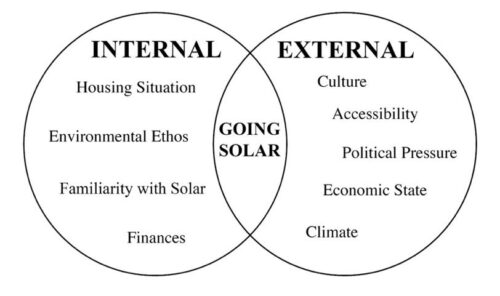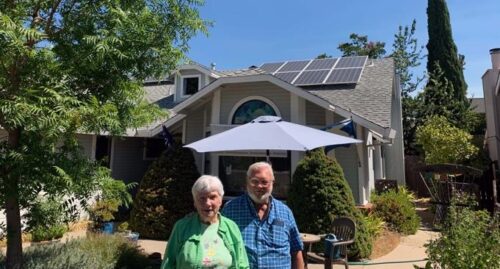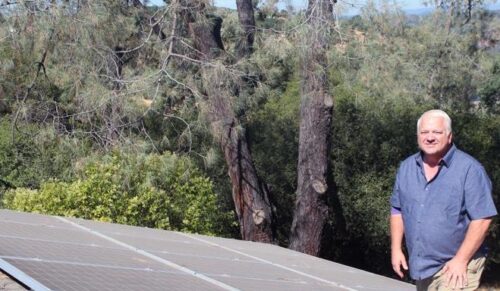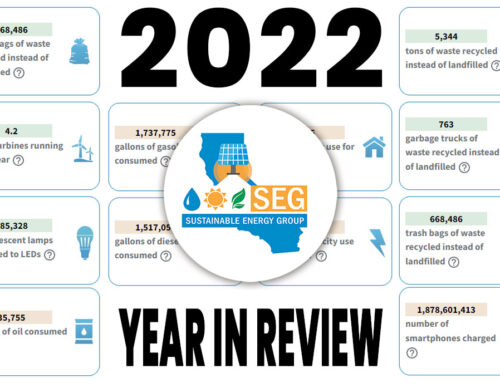Can We Make Change?
What does it mean to make change?
Is change when you spontaneously dye your hair after a breakup?
Or when you buy a new t-shirt because you spilled tomato soup on your last one?
Or maybe change is when you have slept with earplugs in for the past week
because the local band of coyotes are getting louder by the night?
Ultimately, these are all examples of change, and they each have two things in common, an individual action was prompted by the world around them. During my internship with Sustainable Energy Group (SEG), I sought to understand why people make the change to go solar, and how people in the sustainable energy sector can inspire others to do the same.
To understand my approach, let’s get philosophical.
How is change made?
Change occurs when internal preferences line up with what is possible externally. 


In the context of going solar:
the internal environment includes finances,
environmental ethos, housing situation,
and familiarity with solar.
The external environment includes accessibility,
climate, culture, political pressures, and the economic
state of an area.
Where these two circles overlap lies the harmonious area for change – where individuals can see eye to eye with the world around them and choose to go solar.
I have had the unique pleasure of interacting with over 300 SEG solar customers to understand their intention behind switching to solar energy. From phone calls and visits, I have been able to glean their impressions of why they became solar system owner, these findings are included in below.
Top 5 Reasons for Going Solar (Ranked by popularity)
- Energy independence to avoid increasing PG&E utility rates and power outages
- Environmentally ethical to use renewable energy
- Save money on electricity bills or eliminate them altogether
- Financial incentives to go solar including state and federal rebates and tax credits
- Return on investment by increasing home value
What else did I learn?
SEG solar systems are sufficient in providing customer energy needs: Site specific sizing allows for sufficient and even excess energy production to be sold back to the grid. Solar systems can be expanded in the event more energy is required after the purchase of an electric vehicle (EV), for example.
SEG customers are grateful for their battery backup: Being grid-tied without storage means you can still lose power during an outage. Having a battery backup makes a home truly independent and self-sustaining to avoid electricity outages.
Average customer rating: 4.9/5
In my eyes, those who have gone solar are heroes. They weren’t born wanting solar, but after a personal journey, they realized that they can and should go for it. The following videos showcase three customers who, when faced with difficult circumstances such as the state of our planet, frequent power outages, or utility company price gouging, sought out help from SEG for a cleaner and more affordable source of energy.



“It’s nice not to have to pay a company for something you can get for free”
– George and Barbara Dean, Grass Valley, CA – SEG Solar Customer



“We’ve generated 121,000 kilowatt hours of energy and saved 2 million pounds of CO2 from
being released into the air”
– Ken Nittler, Auburn, CA – SEG Solar Customer
–



“I’m letting people know that this is a possibility, this is important, you can do it too, and on the
personal level, I’m really happy I can do this.”
– John Shulse, Nevada City, CA – SEG Solar Customer
You have heard a few success stories, but what about those who haven’t made the switch to solar?
Maybe they won’t to go solar because they are comfortable with the utilities they have, maybe they think they can’t finance the system, and maybe they don’t know it’s even an option for them.
To learn more about the social, political, and economic obstacles facing the mass rollout of solar and what can be done to surmount them, check out my article next week.
Thanks for reading,
Intern Kieran McKenna





